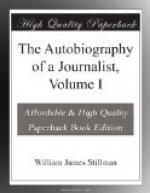Arrived at Euston Station in the small hours of the morning, I bought a penny loaf and walked the streets eating it and carrying my valise until the day was sufficiently advanced for me to go to present a letter of introduction given me by G.P. Putnam, the publisher, to his agent in England, Mr. Delf, who at once took me to a lodging-house in Bouverie Street, in which I got a room for six shillings a week, service included, and an honest, kindly landlady to whom I still feel indebted for the affectionate interest she took in me. I had letters to Mr. S.C. Hall, editor of the “Art Journal,” and the Rev. William Black, pastor of the little Seventh Day Baptist Church at Millyard in Goodmansfields, Leman Street, a very ancient and well-endowed foundation, made by some Sabbatarian of centuries ago, with a parsonage and provision for two sermons every Saturday; and under Mr. Black’s preaching I sat all the time I was in London. He was a man of archaeological tastes whose researches had led him to the conviction that the Seventh Day was the true Christian Sabbath, and to fellowship with the congregation of Millyard. I was admitted to honorary membership in the church, and the listening to the two dry-as-dust sermons was compensated for by the cordial friendship of the pastor, an invitation to dinner every Saturday, and the motherly interest of his wife and daughters. My childhood’s faith and my mother’s creed still hung so closely to me that the observances of our ancient church were to me sacred, and the Sabbath day at Millyard still held me to the simple ways of home. In that secluded nook, out of all the rush and noise of London, we lived as we might have lived in an English village; it was an impasse, and one who entered from the narrow and squalid alleys which led to it was surprised to find the little square of the old and disused graveyard, with its huge hawthorn trees and its inclosure of the parsonage appendages, as peaceful and as far from the world as if it had been in distant Devon.
My letter to Mr. Hall led to introductions to Leslie, Harding, Creswick, and several minor painters, all of whom found me attentive to the lessons they gave me on their own excellences and led me no farther, but it also brought me into contact with a painter of a higher and more serious order, J.B. Pyne, one of the few thinkers and impartial critics I found amongst the English painters. Every Sunday I went out to Pyne’s house in Fulham, walking the six or seven miles in the morning and spending the day there. Kitchen-gardens and green fields then lay between Kensington and Fulham where are now the museums, and there the larks sang and the hawthorn bloomed. After an early dinner we passed the afternoon in talk on art and artists. Pyne was one of the best talkers on art I ever knew, and a critic of very great lucidity; his art had great qualities and as great defects, but in comparison with some of the favorites of the public of that day he was




